Back to 2016 Annual Meeting
A Single Institution Experience with Computer-Aided Surgical Planning in Pediatric Craniofacial Surgery
Wen Xu, Daniel Mazzaferro, Jing Li, Patrick Gerety, Scott Bartlett, Jesse Taylor.
Children's Hospital of Philadelphia, Philadelphia, PA, USA.
Background: Computer-aided surgical planning (CASP) has been well described in the literature for planning and executing a variety of craniofacial procedures. CASP has been purported to decrease planning time and burden as well as to allow for pre-planned complex osteotomies and reconstructions. The purpose of this study is to evaluate the evolving role of CASP in an academic, tertiary, pediatric craniofacial practice.
Methods: Patient records were queried for index pediatric craniofacial procedures from July 2011 to February 2016. These index procedures included conventional orthognathic surgery, mandibular distraction osteogenesis (MDO), cranioplasty, fronto-orbital advancement (FOA), posterior cranial vault remodeling (PCVR), osteocutaneous free tissue transfer, hypertelorism correction, and miscellaneous complex craniofacial procedures. The records were examined for the use of CASP, and trends over time were analyzed. Statistical analysis included descriptive statistics and the chi-squared test.
Results: Our query returned 533 total cases that fit into the pre-specified categories stated in the methods, of which 71 (13.3%) cases involved CASP. The rate of computer planning varied across index procedures: 70% osteocutaneous free tissue transfer, 50.7% orthognathic, 40% hypertelorism correction, 20% miscellaneous complex procedures, 11.7% MDO, 7.8% cranioplasty, and 0% for FOA and PCVR (p<0.0005) (Figure 1). Additionally, we found that CASP utilization has increased over time, with 8.3% of all index procedures being computer planned in 2012, 8.4% in 2013, 16.5% in 2014, and 19% in 2015 (p=0.023) (Figure 2). Although this trend can be seen in many of the index procedures, the major driver of the overall increase in CASP was orthognathic procedures, of which 26.7% were computer planned in 2012 and 80.0% were computer planned in 2015. In the MDO group, all CASP cases were for patients requiring curvilinear distractors. Finally, nearly all osteocutaneous free tissue transfer cases, which included fibula free flaps for maxillary or mandibular reconstruction, involved CASP.
Conclusions: This study demonstrates the increasing role of CASP in a comprehensive craniofacial center, especially in orthognathic surgery, osteocutaneous free tissue transfer, curvilinear mandibular distraction, and hypertelorism correction. We believe that this trend will continue with expansion into yet unchartered areas of pediatric craniofacial surgery.
 
Back to 2016 Annual Meeting
|
